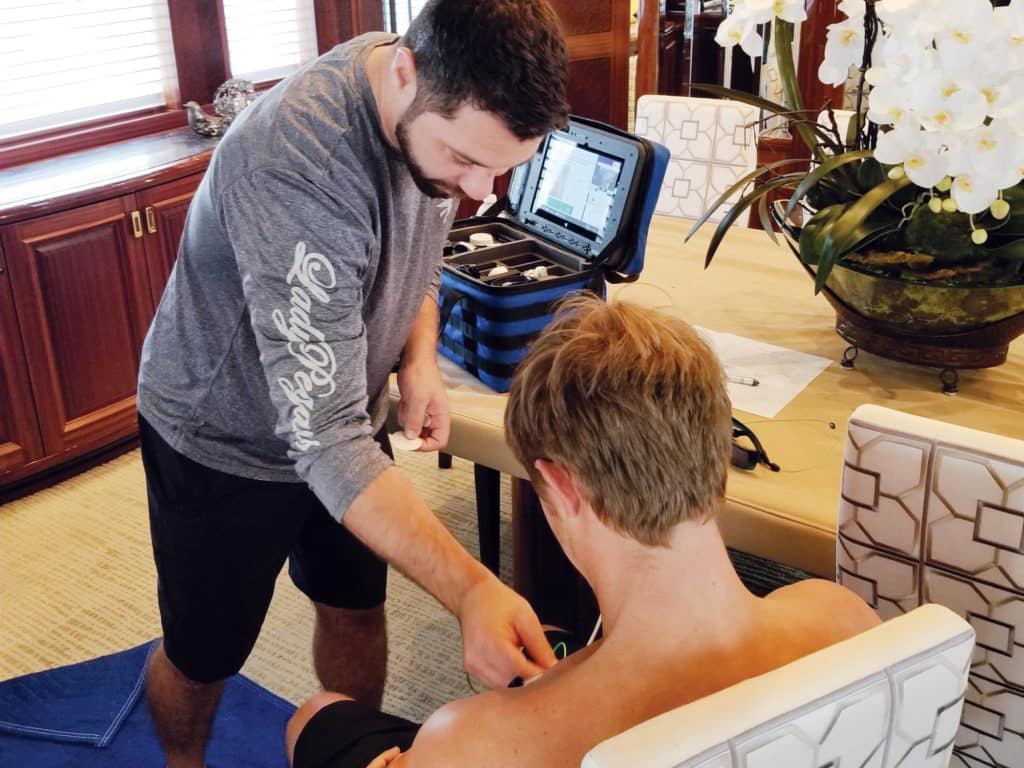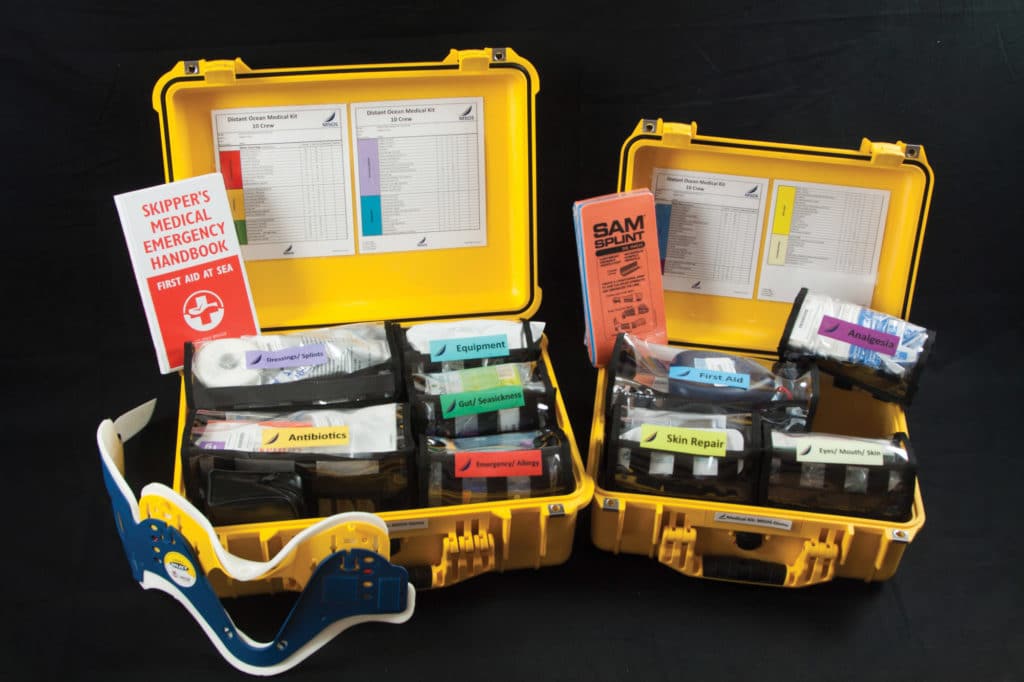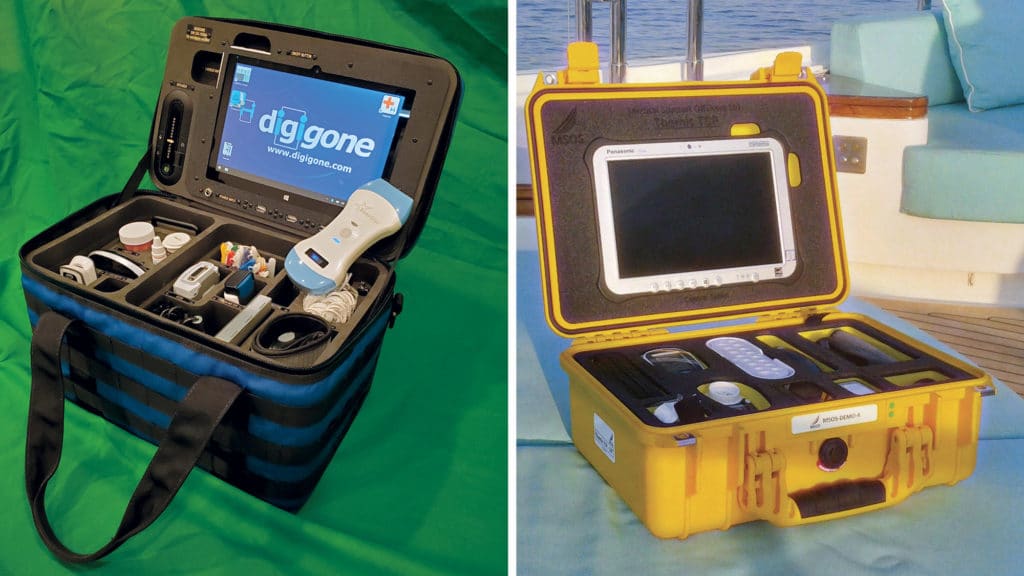
Rebecca Castellano knew that something was fishy when Frank, her then partner and now husband, insisted that she join him and his crewmates for a new-crew orientation the day before the 2012 Fort Lauderdale to Key West Race. Castellano is an experienced sailor and a registered nurse, but she wasn’t part of the Oyster 48′s race crew. Nevertheless, she agreed to go, so long as she didn’t have to do any heavy lifting. Several hours later, when the team was two hours from shore, her partner started experiencing extreme shortness of breath. Realizing that the situation was serious, Castellano made him lie down in a prone resting position and gave him an aspirin to chew. The boat high-tailed it for shore, and Castellano got him to the hospital for treatment.
Only later did she learn that her partner was experiencing symptoms that could have led to a heart attack. Attending doctors told her that a coronary artery (known as the “widow-maker”) was 99 percent occluded and that her swift and decisive actions saved his life. Castellano, besides being a sailor and a nurse, has long worked for telemedicine companies, including Medical Support Offshore (msos.org.uk), which is located in Southampton, UK, and which we will discuss below.
While this crew was incredibly lucky to have a skilled nurse aboard, most boats don’t carry trained medical professionals with them when they head offshore unless, of course, a doctor or a nurse happens to be part of their crew. Fortunately telemedicine technologies and services can help fill this void, irrespective of a boat’s position.
Telemedicine dates back to the 1870s, when Alexander Graham Bell reportedly used one of his early telephones to call for help when he accidentally spilled acid on his trousers. Mariners, however, had to wait for the advent of dependable cellular- and satellite-communications platforms to fully leverage telemedicine. Now that these technologies exist on an affordable level, there have been many documented cases of sailors relying on them to get professional medical help far from shore.
One of the best-known examples of this occurred during the singlehanded Golden Globe Race of 2018, when British solo skipper Susie Goodall, sailing aboard her Rustler 36, DHL Starlight, pitchpoled and dismasted some 2,000 nautical miles west of Cape Horn, South Africa. Goodall was tossed across her cabin during this calamity and suffered a concussion. When she came to, she activated her EPIRB and called the race organizers on her satellite phone. The organizers patched her through to MSOS, their telemedicine provider, and MSOS’s doctors began monitoring her situation and providing direct medical advice. Goodall was rescued by a cargo ship, and while her circumnavigation was over, the story illustrates that telemedicine can provide a critical safety net, even in remote stretches of the Southern Ocean.
Remote medical help comes in several different forms. The most basic option is a subscription service that provides mariners with a phone number to call using their cellular or satellite phone should things go south. This typically connects sailors with a call center that’s staffed around the clock, which then patches them through to an attending doctor who can talk to the patient or others on board in order to provide medical advice, a diagnosis and treatment instructions.
DAN Boater (danboater.org), located in Durham, North Carolina, started out as a medical service for divers (Divers Alert Network), but they now also cater to cruisers. The organization maintains a 24-hour emergency hotline (919-684-9111) that connects callers with specialists ranging from dive medics to physicians. DAN Boater offers memberships ($35 per year for individuals or $55 per year for families; this includes three levels of insurance), however anyone can call the hotline to get assistance, irrespective of their membership status. While DAN Boater made clear that this service is not “telemedicine” (as this insinuates a legal relationship) and that they do not provide medical advice, their experts are on hand to make “recommendations” based on the caller’s descriptions of an injury or ailment. Unlike some of the other companies and services discussed in this article, DAN Boater does not sell communications kits, so callers must have access to a telephone that they can use to communicate with the hotline. This can be a cellphone or satphone, or even a voice-over-internet-protocol connection that’s able to call the company’s hotline.

Actual telemedicine services typically include prepackaged medical kits that are organized and inventoried by the service provider. These kits usually include prescription and over-the-counter drugs, as well as medical equipment such as diagnostic tools, splints and sutures. Depending on the service, telemedicine providers usually keep up-to-date records of the kit’s contents, and they can utilize this information to help direct the patient or crew on the best diagnostic procedures to perform and which medicines to take. Services also usually offer or even mandate in-person or online training courses to educate the vessel’s captain and sometimes its crew about the kit’s contents, which can make a huge difference in an emergency situation.
Not surprisingly, higher-end systems tend to employ additional technologies to give attending physicians more-relevant data when faced with serious calls from remote locales.
Michael Dunleavy, founder and owner of the telemedicine firm DigiGone (digigone.com), says, “We virtually bring the doctor to the patient as long as there’s internet connectivity.” To accomplish this, DigiGone’s Five Plus Telemedicine kit, which sells for less than $20,000, includes a built-in Wi-Fi router and a custom-built 10-inch Windows quad-core tablet that’s Android-, iOS- and Windows-compatible, and features a built-in webcam. This system can leverage any internet connection—cellular, long-range cellular, Wi-Fi and satellite communication systems—to run the company’s Patient Consult app, which resides on the tablet.
Once the crew opens the kit and launches the Consult app, a doctor at George Washington University’s Maritime Medical Access is alerted and can sign into the app on their end and control the kit remotely. A skipper can also reach their own preferred telemedicine physician if they’d like.
If needed, multiple doctors and specialists can view the kit’s streamed data and voice and video communications, and prescriptions can be called in to the boat’s next-closest port.
DigiGone’s kit consists of off-the-shelf Food and Drug Administration-approved devices, including a digital blood-pressure cuff, glucose meter, digital thermometer, electrocardiogram (EKG) machine, pulse oximeter, electronic stethoscope, USB macro camera, USB otoscope and disposable headsets. Data from these tools is streamed onto the company’s DigiMed Consult dashboard and is available to all attending telemedicine doctors. While this data is often vital to the doctors, the sailors using the tools don’t need medical training. “It’s designed so that a nonmedically trained person can use it,” Dunleavy says. “It’s intuitive and easy to use.”
The entire system is designed to work with narrow-bandwidth connections, which is key for cruisers plying remote waters. Dunleavy says that DigiGone kits require only 9 Kbps for device-streaming audio, and 25 Kbps for video streaming, however he advises that the system’s ideal connection speeds are 70 to 90 Kbps. By comparison, a high-quality Skype video call requires 400 Kbps.
The kit can operate using thin amounts of bandwidth thanks to the company’s data-compression tools. A skipper can further reduce the kit’s data needs by adjusting image-quality and bandwidth settings to match their available internet access. Also, all transmitted data is secure. “Users cannot turn off the encryption,” Dunleavy says.
DigiGone, based in Largo, Florida, recently partnered with RealWear, which builds ruggedized, wearable, hands-free Android computers. This partnership allows for higher-level remote collaboration. “You’re watching the doctor demonstrate how to sew up a laceration, and the doctor is watching you do the work,” Dunleavy says.
While DigiGone kits are intuitive, Dunleavy says that all subscribers still need to complete the company’s online DigiSchool training annually, and they must also demonstrate their know-how by passing a yearly competency test.

Another major telemedicine provider is MSOS, which helped Susie Goodall get through her Southern Ocean ordeal during the 2018 Golden Globe Race, and which has also worked with other high-profile sailing events, including the America’s Cup, the Clipper Round the World Race and the Volvo Ocean Race.
MSOS is a full-service medical provider to mariners, and offers several levels of service, starting with standard telemedicine support, which costs $2,245; this connects mariners with a doctor-staffed central call center in Southampton, England. The company says its doctors are all sailors or remote-medicine specialists, which gives them additional insight into offshore medicine and the realities of treating patients at sea.
The company offers specialist training courses, and because it owns its own pharmacy, can provide custom medical kits that come stocked with prescription and off-the-shelf medicines and supplies. Coastal cruisers can select MSOS’s Near Ocean Medical Kit, while bluewater sailors can opt for the company’s Distant Ocean Medical Kit.
Once at sea, MSOS’s Themis TCP kit ($22,000) features a tablet-based system that includes peripheral devices, as well as medical-grade encryption and data-compression technology to keep the system’s bandwidth requirements below 50 Kbps. Imagery is queued for transmission, with priority given to the system’s peripheral-device data; if connectivity doesn’t exist, Themis stores this data locally and uploads it when connectivity resumes.
The kit is “a self-contained unit with Bluetooth-enabled medical devices,” Castellano says. She is currently the company’s Americas and Caribbean sales and marketing manager. These medical devices include equipment to monitor temperature, blood pressure, EKG and lung function, as well as insulin monitoring for diabetics. “Themis streams video and photos from the tablet’s front and rear cameras using the vessel’s internet connection to doctors at MSOS’s land-based facility so that they can constantly monitor a patient’s vitals and offer medical advice,” she says. “Support is never broken off until the patient is in medical hands shoreside, or until the doctor deems the patient is in the monitoring stage.”
Though people are reluctant to go to the doctor’s office for seemingly minor ailments when they’re ashore, both Castellano and Dunleavy urge a paradigm shift when it comes to offshore sailors relying on telemedicine. Dunleavy encourages clients to “use it as a walk-in clinic” for seemingly innocuous problems such as hang nails and slight coughs. MSOS shares a similar philosophy. “We want people with minimal medical experience to defer to the doctor,” Castellano says, adding that cost “should never be an impediment to calling.”
Back in 2012, while Castellano didn’t have a MSOS Themis TCP kit aboard the Oyster 48, her quick thinking, medical training and professional experience guided her and her soon-to-be husband through what otherwise would have been a tragedy. For the rest of us, however, telemedicine offers a link to shore, to medical supplies and diagnostic tools, and to the medical community’s wealth of knowledge. This can be absolutely critical, say, if you find yourself dealing with a laceration in the Bahamas, or—more spectacularly—dismasted and concussed some 2,000 miles to the west of Cape Horn.
David Schmidt is CW’s electronics editor.








